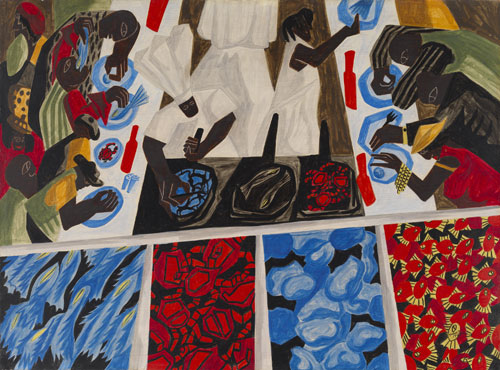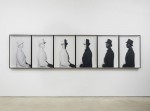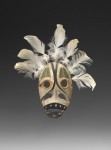A wide range of art acquisitions – including a rare post-World War II modernist painting, important Native American objects, a collaborative work by two contemporary African American artists, and a site-specific glass installation – led VMFA’s year-end acquisitions.
Jacob Lawrence, Catfish Row
Jacob Lawrence’s Catfish Row depicts the shared preparation and consumption of food in black communities, which offered some respite from the hardships of racial discrimination in the post-World War II years. The 1947 painting derives from a Fortune magazine commission, one of 10 temperas by Lawrence depicting African American life in the so-called Black Belt, a broad agricultural region of the Deep South.
This acquisition, in its original pin-oak frame, resonates across VMFA’s diverse African, American, and European collections, while deepening our overall holdings of leading African American artists. Catfish Row joins three other examples of Lawrence’s graphic work in the museum’s permanent collection—the 1943 Subway gouache; 1974 The 1920s…The Migrants Arrive and Cast their Ballot single screen print; and 1977 The Legend of John Brown multiple screen prints. As a tempera on board, it provides VMFA with an important example of Lawrence’s acclaimed art that can be on view indefinitely, unlike the more light-sensitive works on paper that require regular rotation.
Dale Chihuly, Red Reeds
Composed of more than 100 10-feet red glass reeds, this work was produced for the 2012 exhibition, Chihuly at the Virginia Museum of Fine Arts. The reeds were blown at the Nuutäjarvi Glass Factory in Nuutäjarvi, Finland, home to the largest annealing ovens in the world. The red glass in Finland has a particularly brilliant quality, due to the ruby red pigment and the added chemical element neodymium. Chihuly’s work is frequently informed by nature and, appropriately, Red Reeds is displayed among water lilies, lotus, and grasses in VMFA’s reflecting pool of its Robins Sculpture Garden. It represents the first site-specific outdoor work by Chihuly to be acquired by an art museum. Dale Chihuly’s Red Reeds is now a permanent fixture in the E. Claiborne and Lora Robins Sculpture Garden.
Hank Willis Thomas, Zero Hour
An acclaimed young artist, Hank Willis Thomas often appropriates mass media images and texts, which he manipulates to explore tacit assumptions and attitudes about black identity. Zero Hour presents fellow artist Sanford Biggers dressed in the guise of a 19th-century minstrel, whose image Thomas found in Emory University’s photographic holdings documenting African American life. Six individually framed images—displayed side by side and measuring fifteen feet overall—feature Biggers dressed in a tuxedo, complete with tails, gloves, and a top hat. The right side of his face and body are white, while his left side is black, creating a striking representation of racial hybridity. A film of Lumisty applied to the glazing causes the images to go in and out of focus as the viewer changes their position—another visual analogy for the increasingly blurry lines of race itself. This is the first work by Thomas to enter VMFA’s permanent collection. It will be featured in the museum’s spring 2014 collections-based exhibition Identity Shifts, held in tandem with the traveling exhibition Posing Beauty in African-American Culture.
Six Native American artworks
Six important Native American artworks come from the Robert and Nancy Nooter collection, acquisitions that significantly enhance VMFA’s permanent holdings of indigenous American art. Two artworks were donated to the museum: an 18th-19th-century dagger from the Pacific Northwest Coast, and a 19th-century mask in the form of an eagle from the Bella Bella of Canada. In addition to these gifts, VMFA also purchased four artworks from the Nooters: a 19th-century dream-dance mask from the Yu’pik of Alaska, carved in wood and accentuated with feathers and paint; an 1865-70 child’s serape from the Navajo of the Four Corners region of North America; a late-19th-century Cheyenne girl’s three-hide dress made of deerskin hide with seed and brass beads; and a late-19th-century Cree pipe accentuated with dyed porcupine quills.
Additional Purchases
American
• Francis W. Edmonds (American, 1806–1863), Courtship in New Amsterdam, 1850, oil on canvas, 25 x 30”. Floyd D. and Anne C. Gottwald Fund.
European
• Marie Bracquemond (French, 1840-1916), Woman with Flowerpots, 1879, hand-colored faïence plate, 10” dia. Ailsa Mellon Bruce Fund.
• Suite de Palissy – dit d’Avon (School of Fontainebleau) (French, 1530s-1610), Pilgrimage Flask, ca. 1600, colored earthenware (terre vernissée), 9 x 6 ¼”. Ailsa Mellon Bruce Fund.
Photography
• James Karales (American, 1930-2002), Selma to Montgomery March, Alabama, 1965, gelatin silver print, printed ca. 1965, 11½ X 16 ⅝”, Look Magazine copyright stamp on print verso. NEA Fund for American Art.
• André Kertesz (American, born Hungary, 1894-1985), Umbrellas, Tokyo, 1968, silver gelatin photograph, 11×14”. Aldine S. Hartman Endowment Fund.
• André Kertesz, (American, born Hungary, 1894-1985), Fountain and Church in Fog, 1917, vintage contact print, 1- 9/16 x 1⅜”. Aldine S. Hartman Endowment Fund.
• Edward Weston (American, 1886-1958), Melting Ice, 1938, vintage silver gelatin photograph, 8×10”. Aldine S. Hartman Endowment Fund.
• Ernest Withers (American, 1922-2007), I Am A Man, Sanitation Workers Strike, Memphis, TN, March 28, 1968, 1968, printed ca. 1990s, gelatin silver print, 20 X 24”. NEA Fund for American Art.
Gifts
African
Seven African objects. Gift of Drs. Kenneth and Carol Adelman, Arlington.
• Yaka (Democratic Republic of the Congo), Phuungu Figure (Charm), 19th-20th century, wood, beads, cloth, fiber, horn, feather, 10⅝”h
• Kongo culture (Democratic Republic of the Congo), Whistle with Frog and Snake Motif, 19th–20th century, ivory, glass beads, fiber, 5⅛”h
• Pende culture (Democratic Republic of the Congo), Whistle, 19th-20th century, ivory, 3¾”h
• Holo culture (Democratic Republic of the Congo), Pipe with Seated Figure, 19th-20th century, wood, metal, 6⅞” long
• Holo culture (Democratic Republic of the Congo), Pipe with Two Kneeling Figures and Crocodile, 19th-20th century, wood, metal, 8¾” long
• Kuba culture (Democratic Republic of the Congo), Cosmetic Box, 19th-20th century, wood, 5½”h
• Kuba culture (Democratic Republic of the Congo), Ngady amwaash mask, 19th-20th century, wood, cowrie shells, glass beds, cloth, fiber, 13”h
American
• Joseph Foxcroft Cole (American, 1837-92), French Farm Scene, 1861, oil on canvas, 13x 21”. Gift of Mr. and Mrs. Charles G. Thalhimer, Richmond.
• Wilfrid de Glehn, (British, born Germany, 1870-1951), Breakfast in the Bower [Déjeuner sous la Tonnelle], 1908, oil on canvas, 40½ x 35½”. Gift of Joseph T. and Jane Joel Knox, Richmond.
• John Koch (American, 1909-1978), Sunday Morning, 1974, oil on canvas, 15 x 15”. Gift of Joseph T. and Jane Joel Knox, Richmond.
Sara November (American, 1900-1983). Gift of Sara Belle and Neil November, Richmond.
• Daily Devotions, ca. 1936, oil on canvas, 22¼ x 28¼”
• Study for “Daily Devotions,” ca. 1936, oil on canvas, 16 x 20”
• Card Players, 1944, graphite, pen, and ink on paper, 11½ x 10½”
• Neil Sleeping, ca. 1934, red conte crayon on paper, 9-15/16 x7½”
• Neil Reading, ca. 1937, graphite on paper, 11 x 8½ “
• Five advertising illustrations, 1920s: Lentheric Perfumes, watercolor on paper, 11 x 8”; three Sachs Wraps sketches, pen, ink, and wash on paper, 31 x 16” (framed); Untitled (Seated Woman), charcoal on paper, 24 x 17¼” (framed)
East Asian
• Hasui Kawase (Japanese, 1883-1957), Forty-Three Works of Woodblock Prints and Watercolors, 1919-1956, various sizes. 40 Prints: woodblock prints, ink and color on paper; 3 Watercolor: album leafs, ink and color on paper. René and Carolyn Balcer Collection, Los Angeles.
European
Antoine-Louis Barye (French, 1796-1875). Gift of Mrs. Nelson L. St. Clair, Jr., Williamsburg.
• Percheron, ca. 1870, bronze (atelier) (L.122.2010.12)
• Bear in a Trough, ca. 1832, bronze (Barbédienne) (L.122.2010.10)
• Wolf Caught in a Trap, ca. 1870, bronze (L.122.2010.8)
• Seated Bear (Bear Assis), 1833, bronze (L.122.2010.9)
• Walking Lion (Lion Qui Marche), 1840, bronze (atelier) (L.122.2010.5)
• Arab Riding a Dromedary, ca. 1874, bronze (atelier) (L.122.2010.4)
• Lion and Serpent (“Lion of the Tuileries”), after 1833, bronze (L.122.2010.14)
• Félix Bracquemond (French, 1833–1914), 180 works on paper; 62 ceramic objects. Gift of Frank Raysor, Richmond.
• Giovanni Battista Piranesi (Italian, 1720–1778), 127 works on paper. Gift of Frank Raysor, Richmond.
About VMFA acquisitions
These works of art were approved by the VMFA Board of Trustees in December 2013. VMFA is a state agency and a public/private partnership. All art is purchased with private funds from dedicated endowments. After VMFA’s board approves proposed acquisitions on a quarterly basis, the art becomes the property of the Commonwealth of Virginia to protect, preserve, and interpret.
About the Virginia Museum of Fine Arts
VMFA’s permanent collection encompasses more than 33,000 works of art spanning 5,000 years of world history. Its collections of Art Nouveau and Art Deco, English silver, Fabergé, and the art of South Asia are among the finest in the nation. With acclaimed holdings in American, British Sporting, Impressionist and Post-Impressionist, and Modern and Contemporary art – and additional strengths in African, Ancient, East Asian, and European – VMFA ranks as one of the top comprehensive art museums in the United States. Programs include educational activities and studio classes for all ages, plus lively after-hours events. VMFA’s Statewide program includes traveling exhibitions, artist and teacher workshops, and lectures across the Commonwealth. VMFA, a certified Virginia Green attraction, is open 365 days a year and general admission is always free. For additional information, telephone 804-340-1400 or visit www.vmfa.museum.
# # #



